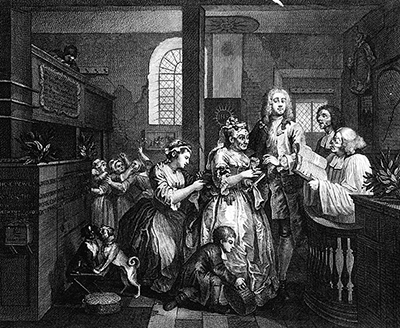William Hogarth was an English painter of the 18th century born on 10 November 1697. He was a man with a scar on his forehead and an artist who designed his world exactly the way it was and through this he was able to change the society view of the art.
In 1735 he worked on his piece “Tom marries an old maid” using engraving and etching as his medium laid on a paper and printed using black ink. It has the following dimensions plate: 14 by 16 inches (35.6 by 40.6 cm) and sheets: 18.5 by 23 inches (47 by 58.4 cm). This was a continuation of a Rake’s progress series. The series focuses on the reckless life of tom Rakewell and consisted of eight pictures. He tell the story of Tom an heir of a wealthy merchant who spends all his money on a luxurious life in the city with the prostitutes and gambling and ends up in a Hospital. The fall of the young rich man from the third picture tells the evils of the 18th century and in the 5th picture he and a wealthy maid stand before the clergy reciting their vows in a marriage ceremony.
Born in a lower middle class family in London with his father experiencing hardship with mixed misfortune and at some point going to prison for his debt, William took apprenticeship with an engraver Ellis Gamble where he learnt how to engrave. He worked and supplied the market with trade cards and labels and in 1727 he was hired by Joshua Morris to work on a design “element of earth”. Influenced by French and Italian paintings he worked on his early satirical pieces such as the” lottery” and “an emblematical print on the south sea scheme “which he loved and highly regarded. In 1731 he completed one his earliest pieces entitled “a harlot's progress” that led to his recognition as an artist. The series is a story of a simple country girl who begins prostitution and eventually ends with her contracting a venereal disease which leads to her death.
He continued to paint a series of arts including some self-portrait and also wrote and published in 1753 his ideas of artistic design in his book the analysis of beauty which gained so much praises from the people. He inspired and influenced so many people including John Collier. His work spread and was appreciated by many across Europe in the 18th and early 19th Century and still continues to inspire many artist up to date by providing them with subjects for their pieces. He later died on 26 October in 1764 and was buried at Chiswick with his friend David Garrick compositing some inscription for his tombstone.
Some of his other pieces include:
- Marriage A-la-Mode in 1743-1745 which consisted of six pictures and told a story of how people in the 18th century considered marriage for money
- Portrait of Captain Thomas Coram in 1740
- The Shrimp Girl in 1740–1745




